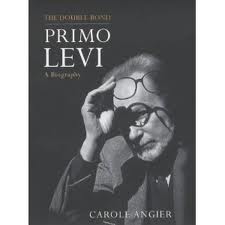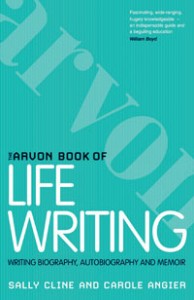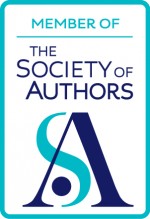Last week I posted the first part of my interview with biographer Carole Angier, co-author of the excellent new publication The Arvon Book of Life Writing. You can read the story of how I came to meet Carole by going to Part 1.
INTERVIEW WITH CAROLE ANGIER: Part 2
Fiona: So – continuing where we left off…
Q5. In Clare Mulley’s contribution to your book she writes very entertainingly about her journey as Eglantyne Jebb’s biographer (The Woman who Saved the Children, One World). Can you single out some of the highs and lows when you were writing each of your biographies on Jean Rhys and Primo Levi.
Carole: There were so many lows! On Jean Rhys I remember a moment when I felt very low for her: when her only surviving relative told me that the family was so embarrassed by Jean’s books, they kept them in brown paper wrappers.
I think my highest moment on Jean Rhys was when I discovered the identity of her great love, the model for Walter in Voyage in the Dark (and for Neil James in After Leaving Mr Mackenzie – and, I argue, for Rochester in Wide Sargasso Sea.) All I knew was that he had been a stock-broker, like Walter; and all I had was one brief note she’d kept, starting ‘Dear Kitten’, and signed ‘Lancey’. Because of that ‘Kitten’, I guessed that ‘Lancey’ was Jean’s pet name for him, her knight in shining armour. The letter paper had only a telephone number embossed on top. But by searching through the stock-brokers of 1911, I found it: Rowe & Pitman, a very pukka old firm, stock brokers to the Queen. There I stuck for a while: if all I had was a pet name, how could I ever find him? Then, on the third or fourth hopeless gazing at the Rowe & Pitman directors, I saw it: Lancelot Hugh Smith, halfway down the list. Could it be – ? Could ‘Lancey’ have been his real name? Jean’s executor, Francis Wyndham, had told me that she often talked of Lancey’s beautiful house on Charles Street, near Berkeley Square. So I got out a pre-World War I Kelly’s Street Directory – one of the biographer’s trustiest tools – and turned to Charles Street, Berkeley Square. And there he was: Lancelot Grey Hugh Smith, at No 30.
I wanted to shout with joy – but I was in the Bodleian Library, where shouting had been forbidden for centuries. So I buried my head in my arms and shouted soundlessly into the table.
On Primo Levi there was a moment that started high, but ended seriously low.
I had known for a long time that Levi’s marriage was a sort of prison. This was important, because prison was a major theme of his life, and of my book; and also because the trouble in his marriage was both a cause and an effect of his depression.
Everybody in Turin knew this, and everybody told me in roundabout ways, but no one would come right out with it, or be quoted. Then one day I went to talk to a friend of Levi’s – one of those distinguished intellectuals, with whom I was expecting to have an intellectual conversation. Instead he launched into a passionate diatribe against Levi’s wife and mother, and a moving description of Levi, driven to suicide by these incubi. I didn’t believe every word, but much of it confirmed things I already knew. I went home racked with pity for Levi, but jubilant to have such eloquent quotes for my book.
The next morning he rang and asked me to come around immediately. When I got there he said: “What I told you yesterday was a mistake. If you attribute anything of the sort to me, I shall be forced to deny it. Good day.”
Q6. On p223-4 the advice on writing dialogue in biography (and memoir/autobiography) was extremely helpful. In fact I’d have paid the cost of the book just to read those pages! How much of a danger is it to borrow narrative techniques from fiction?
Carole: I think it’s essential to borrow narrative techniques from fiction, and Sally and I devote half the practical part of our book to discussing how to do it – how to introduce pace and suspense, rhythm and variation, imagery and symbolism; how to develop character, play with order, and yes, use dialogue, or substitutes for it – quotations from letters, diaries, emails, etc. Good biographical writing has never been dull, from Plutarch onwards; but it is more important than ever to make it vivid and engaging, for the reasons we’ve already mentioned.
The trouble is that biography must respect reality, and so cannot produce the effect of reality – l’effet du réel – as fiction can, by invention. You cannot say ‘It was an eerily calm day’ or ‘She held her breath in terror’ unless you have proof (a weather report; a diary or letter.) You must be objective, and you must respect the limits of knowledge; so you are stuck with the historian’s third-person narrative voice, you cannot enter your character’s minds at will, and you are often forced to speculate (‘She must have held her breath…’). All this means that dullness is the great risk, and the borrowing of fictional techniques a necessity – but at the same time it means that you can’t borrow them, beyond a certain point, or you’ll lose your reader’s trust. This is the danger you raise in your question, and you’re right to raise it. A racy paragraph that would be perfectly fine in a thriller (‘It was an eerily calm day. She held her breath in terror…’) will – or should! – make the biography- reader chuck the book in the bin. Even the careful use of a fictional technique can raise questions in the reader’s mind. How does the biographer know what her subject said to her lover in bed? How does the memoirist remember every word of a conversation she had 15 years ago?
In sum, biographers should use fictional techniques – but with care. What makes a good novel hard to write is that you have to invent, what makes a good biography hard to write is that you can’t. I know which I think is harder.
Q7. Tell me some more about your teaching/mentoring roles at Arvon and on the Gold Dust mentoring scheme. What do you find rewarding? Are there any frustrations? What do new biographers tend to need most help with?
Carole: I love the mentoring I do – especially in life writing, which I do at Arvon and on Gold Dust, as you say, but also at Birkbeck, where I’m a tutor on the Creative Writing MA. I also enjoy teaching academic writing, which I’m doing for the RLF again this year, after a long absence (at Oxford Brookes this time, which I’m really looking forward to.) It’s very demanding, and it uses a lot of the same energy you need for writing. But that’s always the dilemma in the creative trades – do you take a day job you enjoy, and that uses your skills, but may use them up; or do you take a completely different, boring job you hate, but that leaves your creative energy intact? For me at least, a boring job destroys my energy anyway, so there’s no contest. I love meeting young people, which I don’t do much in the ordinary way since my son left home; I love having colleagues, and a library card, and an institutional affiliation, which is a lot more respectable in the eyes of the world than writing. And not least I love working with good writers. The frustrations? – working with people who want to be writers, but don’t really want to write. That’s a recipe for disaster.
As to what new biographers need most help with – the same things old ones do. All the challenges Sally and I cover in our book, especially the main one I’ve already mentioned – combining accuracy and objectivity with elegance and excitement.
Fiona: Finally, let’s gaze into the crystal ball…
Q8. I remember a talk by Professor David Dutton, author of political biographies, where he raised the issue of the ephemeral nature of modern communication – texts, real time chat, emails – rather than letters. It’s interesting because in some ways we leave less ‘hard copy’ evidence of our lives, yet in other ways we leave a huge ‘digital trail’ of stuff through Facebook, Twitter and our blogs. I wonder, do you think Life Writing in the future will become easier or more difficult, or will the research methods just be different?
Carole: I’m sure they’ll just be different. But I’m glad I was around in the old days, when the problem was too little evidence, rather than too much, and when you could touch the paper someone wrote on, and see their handwriting. Biography is the art par excéllence of the human individual, but each advance in technology leaves less room for the individual.
Still, that started to happen when writing took over from oral memory, and when printing took over from pen and ink. It’s just me there won’t be room for in the future. I’m sure biography will be fine.
Fiona: Thank you Carole for generously sharing your insights into the practicalities of being a biographer.
All comments and questions welcome.
Fiona Joseph




4 Comments
What a fantastic insight! I really enjoyed the highlights: it must have been a wonderful moment when you came across ‘Lancelot Hugh Smith’ and were able to join the dots.
Just occcured to me that an ‘extras’ section of a biography similar to that found on DVDs would be a fascinating addition. The kind of stories you tell here would make a wonderful introduction to a book: certainly this kind of material would serve as great publicity for inclusion on an author’s blog.
Thanks for the post!
This is a really engaging and useful insight to the biographer’s job, Fiona, and you present the interview well. You should think about publishing this in another form, an article or something like that. I wonder if the Paris Review would be interested? http://www.parisreview.com/ Click on interviews.
I’m serious. You would need to expand the interview to discuss the two biographies as well as the techniques of writing them. It would be good practice for you as a biographer and publicity for yourself as well.
As if you haven’t enough to do!
N x
Hi guys – really glad you both enjoyed reading the interview with Carole. I was fascinated too! She’s a lovely lady, with huge amounts of knowledge/experience and she was very generous with her time and advice.
Nick, I loved your idea of an extended interview written up as an article. I had a look at the Paris Review interviews and found them inspiring… you’ve got me thinking now.
Fiona x
nice article, keep the posts coming